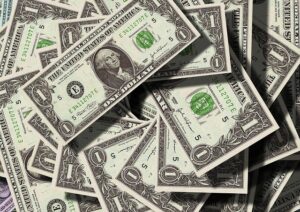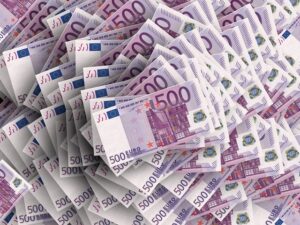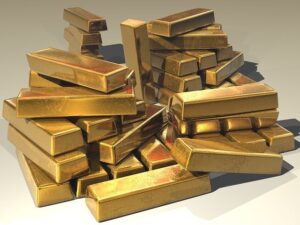
What exactly is money?
When was money created, and who devised it?
Money’s history is fascinating, dating back thousands of years. From bartering to the first metal coins and bills, money has had a major influence on how we live as a society through the ages.
In this article, we’ll discuss the origins of money and how people from a barter economy to a sophisticated financial system with numerous sorts of currency.
Continue reading for a comprehensive summary or use the links below to jump to a particular section.
What exactly is money?
Money, on the other hand, does not have an inherent value. Instead, money is a thing that has a price tag assigned to it and maybe exchanged for items and services.
Metal coins have actual worth in terms of the materials used, whereas paper money is more common in today’s world and has little real value.
Currency has taken many various forms over the years, with different countries having their own unique denominations.
When Was Money created?
People bartered for products and services before money was invented.
It wasn’t until about 5,000 years ago that the Mesopotamian people developed the shekel, which is considered to be the world’s first known form of currency.
Gold and silver coins date back to around 650 to 600 B.C. when stamped coins were used to pay soldiers in Lydia, now part of Turkey.
Who devised money?
Different people and civilizations have devised money over the years.
The Mesopotamian people were the first to develop currency, followed by the Greeks, Romans, and Chinese.
More recently, John Law helped devise paper money in France during the early 18th century.
The Bank of England began issuing paper money in 1695.
What Were People Using Before Money?

When the money did not exist, people bartered goods and services for the items they required.
A farmer might swap livestock for vegetables with another, while a laborer or lumberjack may exchange labor or wood for cattle.
These early trade deals would go on to form the future of money as we know it today.
The History of Bartering
Bartering has been around since the dawn of man, when Mesopotamian tribes taught the Phoenicians about it.
Items were traded for one another in the absence of cash, including tea, salt, weapons, and food.
Bartering continued to develop over time, with Colonial Americans trading pelts, crops, and muskets.
The first Metal Money was a coin
The first metal money dates back to 1000 B.C. in China.
These coins were produced from pressed pieces of valuable metals such as bronze and copper. Ancient Greeks utilized early versions of coins beginning around 650 B.C.
Coins were a major step forward in the history of currency because they were one of the first currencies that permitted people to pay using a form of money that has a real value in the world.
The early coins
There have been several different coins in use throughout history. The first round coins were produced and inscribed with gods and emperors for authentication around 500 B.C.
In AD 800, Charlemagne introduced the silver penny, which became the normal coin in Western Europe from 794 to 1200. By the mid-13th century, the shilling and groat were also in circulation.
First Paper Money

Although paper money was created in China during the 700s to 800s A.D., it would be other several centuries before it became widely used.
According to Brittanica, China was the first country to use paper currency, which it did until approximately 1455. The lighter weight of paper money allowed for international commerce, which created both pros and cons.
The first banknotes in Europe
The first paper money was introduced to Europeans as a way to avoid carrying around gold and silver coins, which were heavy and easy to steal.
Paper money began circulating in Sweden during the years 1661 – 1667.
As Brittanica reports, King Karl X ordered that the Royal Mint start producing paper money, which was named “banknotes” because they were issued by the Riksens Ständers Bank, the precursor to Sweden’s central bank.
The first American banknotes
The first banknotes in America were produced in 1695 when the Bank of England began issuing them as promissory notes. The notes were used to finance England’s war efforts against France.
The first American banknotes were issued in 1775 by the Continental Congress to help fund the Revolutionary War.
Bills of Exchange
In the 19th century, bills of exchange began to be utilized in business and commerce.
A bill of exchange is a contract between two or more parties that outlines the terms for paying a fixed amount of money at a specific time.
One of the early applications of this order was in international trade, where it was used to settle accounts.
Currency Wars
The creation of paper money would eventually lead to currency wars, in which nation’s leaders compete to devalue their own currency.
This causes demand to rise and helps stimulate their economy.
While this still occurs today in the foreign exchange market, the signature of a currency war is that several countries are involved in the debasing of other countries currencies.
Currency wars were last seen at the end of World War II.
Banks were first introduced
Around 1800 B.C., the Roman Empire established the first banks.
These banks provided loans and took deposits from individuals, but they vanished with the fall of the empire. Banks grew respectable organizations in communities by the end of the century, learning about fractional reserve banking.
Because people didn’t all withdraw their cash at once, banks figured out that they could loan out a lot more money than they actually had.
The Gold Standard is a monetary standard

England made gold the official currency in 1816.
This implies that each banknote represented a certain quantity of gold, thus only a limited number of banknotes could be produced.
This gave previously unbacked money some semblance of value and stability.
In 1900, the United States approved the Gold Standard Act, which brought it into line with other nations with a similar system.
The Bretton Woods Agreement
The Bretton Woods Agreement was an international monetary agreement that was put into effect in 1944.
The goal of the agreement was to create a stable and predictable global financial system in the aftermath of World War II.
Key to this system were rules governing how much gold each country could possess, as well as the establishment of the International Monetary Fund (IMF) and the World Bank.
Paper money
Though paper money has been used for centuries, it is still not without its detractors.
Some people argue that because it is not backed by anything tangible, it is essentially worthless.
Others claim that the printing of too much money can lead to inflation, which can devalue a currency or even cause it to collapse altogether.
Money In This Day and Age

Now that you know about the history of currency, let’s take a look at how it is used today.
Money has taken various forms, including the US dollar and cryptocurrencies like Bitcoin, these days. Buying, selling, and trading are now easier than ever thanks to the invention of modern-day money.
Credit Cards & Debit Cards
Credit cards and debit cards are popular because they are quick to use.
Debit cards have a set amount of money stored in them from your bank account, which is removed from your account after each transaction.
In contrast, credit cards do not charge interest on purchases for the first year after you make them.
After that year passes, though, you will be required to pay back whatever amount you spent until then.
Credit limits are determined by lenders and may be as low as $100 or higher than $25 million, depending on your credit score. Credit cards may also offer rewards, which can include cash back or free merchandise.
- See also: The history of glass – how glass was invented
- See also: The history of how the telegraph was invented
Online Payments
Money was formerly transacted physically, usually in the form of coins or paper money.
Online payments have become increasingly easier as a result of the Internet bubble and eCommerce’s growth.
Today, online payments are one of the most popular methods for purchasing things and services. You may pay for items you want using a credit or debit card number on a website simply by entering it.
Online payments can also be made with a bank account number and routing number, but this might take days. When you use a debit or credit card to make purchases online, the merchant makes a payment request into your bank.
The money is then transferred from your account to theirs almost instantaneously.
Digital Currency
In the 1990s, digital currency tried and failed to take off, but in the 2000s things have changed, allowing it to flourish in popularity and use.
In reality, cryptocurrencies like cryptocurrency and virtual currency play an essential role in today’s economy.
These currencies have a value assigned on them just like real money does, with billions of dollars worth of these currencies exchanged daily.
Cryptocurrencies are unique in that they use cryptography to secure and track transactions, as well as to prevent counterfeiting.
Cryptocurrencies are also decentralized, meaning there is no one person or entity controlling them.
Bitcoin, the most popular cryptocurrency, was created in 2009 by an anonymous person or group of people known as Satoshi Nakamoto.
Conclusion
So, there you have it – a brief history of money and some examples of how it is used today.
Whether you’re buying something online or using your credit card to travel the world, you’re using money in one way or another.
Keep in mind that there are always new ways being developed to use money, so you will probably be using it in new and creative ways in the future!



